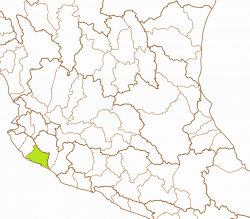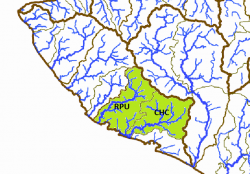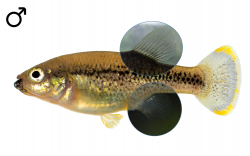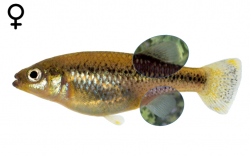Xenotaenia resolanae
TURNER, C. L. (1946): A contribution to the Taxonomy and Zoogeography of the Goodeid Fishes. Occasional Papers of the Museum of Zoology University Michigan No. 495: pp 1-15
Collection-number: University of Michigan Museum of Zoology, Cat. No. UMMZ-143024.
The Holotype is a mature female of 34mm standard length, collected by B. C. Turner on March the 29th, 1939. Together with the Holotype, the author collected two Paratypes, a smaller female and a mature male (Cat. No. UMMZ-143025).
The left picture shows one of the oldest known photos of Xenotaenia resolanae, a male from Millers collection near the town of Resolana, published in 1984 (E. Pürzl), the right one a male collected in 2008, prepared for a scientific fish collection with the corresponding tag with collection data:
The Holotype was collected from a tributary to the Río Purificación, the Río Resolana, about 25 miles SW of the town of Autlán in the federal state of Jalisco.
Though Turner didn't explain why he had chosen this epithet, it is very likely, that the species is named after the type locality, the Río Resolana.
The genus was erected by Turner in 1946 and the generic name can be derived from the ancient Greek. The word ξένος (xénos) means strange and ταινία (tainía or taenía) band or ribbon, this has to be seen as a reference to the different type of trophotaenia of this species. The name of the genus can therefore be translated with "a strange type of ribbon" in the meaning of "strange trophotaenia".
none
The Leopard Splitfin is endemic to the Mexican federal states of Jalisco and Colima. It occurs in two river drainages on the Pacific Slope, the Río Purificación drainage with the Río Purificación and its tributaries, including the bigger ones Río Amborín and arroyos El Tecolote and Carmesí, and the Río Marabasco drainage with the Río Marabasco and its tributaries, among them the bigger ones ríos Ayotitlán and Cuzalapa. The distribution area encompasses the bigger affluents of the Río Cuzalapa, too, the Río Patita and the Arroyo Las Marías. Affilated to two distinct river drainages, two subpopulations can be distinguished: The Río Purificación subpopulation (type subpopulation) and the Río Marabasco subpopulation. The bold names are the ones officially used by the Instituto Nacional de Estadística y Geografía; nevertheless, other ones might be more often in use or better known and therefore prefered.
ESU ist short for Evolutionarily Significant Unit. Each unit expresses an isolated population with different genetic characteristics within one species. ESU's can be defined by Molecular genetics, Morphology and/or Zoogeography and help in indicating different phylogenetic lineages within a species. The abbreviation for an ESU is composed of three letters of the genus, followed by the first two letters of the species name and an ongoing number in each species.
Xenotaenia resolanae inhabits two river systems being isolated from each other. Those systems lead to two different ESU's. Fish from the southern one, the Río Marabasco with its tributaries (ríos Cuautitlan and San Antonio, and the arroyos Las Marias and El Durazno) belong to Xenre1, whereas fish from the northern one, the Río Purificacíon (with Río Resolana and the arroyos Tecolote and El Conejo) belong to Xenre2.
The left map shows the Río Chacala-Purificación basin from the Hydrographic Region Costa de Jalisco on a Mexico map. The right map shows the two subbasins where the Leopard Splifin occurs: The Río Purificación (RPU) and the Río Chacala subbasin (CHC). Xenre1 is known from the Río Chacala, Xenre2 from the Río Purificación subbasin:
International Union for Conservation of Nature (IUCN): Vulnerable
Distribution and current conservation status of the Mexican Goodeidae (Lyons et al., 2019): Vulnerable/stable: „This species is known historically from a total of ca. 20 locations. Xenre1, which occupies the upper Marabasco River basin, is vulnerable, and occurs at approximately ten locations. The populations, while small, seem to be stable (Lyons and Navarro-Pérez, 1990; Lyons, 1996; Domínguez-Domínguez et al., 2005; Lyons unpublished data). Xenre2, which occupies ca. ten locations in the upper Purificación River basin, is also vulnerable. Water pollution from sugar mill discharges, human sewage, and animal wastes had eliminated or reduced several populations by the 1980s, but since then the remaining populations seem to have stabilized.“
NOM-059-SEMARNAT-2010: no categoría de riesgo (no category of risk)
Xenotaenia resolanae can typically be found in pools of clear to turbid streams, over substrates of silt, mud, sand, rocks, leaves and bedrock or boulders. Except for green and brown algae, Potamogeton, Eichhornia and Ceratophyllum, there can be usually found no aquatic vegetation. The currents are none to slight or moderate. This species prefers depths less than 1m, typically not under 0.5m. Temperatures in March and April 1975 were between 22.8 and 25.6°C and the habitats partly shadowed by trees.
Miller caught young fish in March and April (1975) with total lengths of 13-14mm. Dolores Kingston reported under captive condition a reproduction all year long except for the months August and December (1979), suggesting a long reproductive period.
The gut is relatively short (0.85% of the total length) and the teeth of the anterior row are bifid. The length of the gut and very strong jaws suggest a carnivorous feeding habit, while the teeth might be an indication for being omnivorous. However, observations under captive conditions indicate this species is more carnivorous.
The ground-colour is greenish-vellow, the dorsal part more greenish, the venter yellow. In younger specimens the posterior halves of the scales are darkened by brown and black pigment cells above the lateral line for the entire length of the body and in the belly region for some distance. Along the lateral line there are about 15 irregular patches. In older specimens, these dark patches often become broken up or disappear, whereas the markings upon the individual scales dorsal to the lateral line become more conspicuous. The posterior edges of the scales on the upper part of the body have a metallic glimmer. There are 3 irregular, vertical brownish bars on the caudal fin with many whitish dots between them . The posterior margin of the dorsal fin is edged sparsely with light brown and the tips of the pelvic fins are white. Pectoral fins and anal fin are clear.
At first appearance, males and females of the Leopard Splitfin are not very easy to distinguish. The safest characteristic is the Splitfin in males, means the for Goodeinae typical mating organ formed by a notch after the first seven shortened rays of the Anal fin. Additionally, male Xenotaenia resolanae have a bigger Dorsal fin than females. A third, but very unsteady character is the colouration with males displaying the yellow terminal band in Caudal and Dorsal fins usually more clearly than females, but sometimes females are more intensively coloured.
Turner noted, that the head is unusually long in proportion to the total length and that the caudal peduncle differs little from the other species in proportion to the length. These facts together indicate, that the body in relation is much shorther than in other species. Xenotaenia is the closest relative of the genus Ilyodon and forms with it a sister group to Allodontichthys.
Looking on the biotopes of Xenotaenia resolanae, they suggest the species may prefer a habitat with moderate to swift current, structured with rocks, roots and small areas with dense submerse vegetation. Intraspecific aggession is sometimes observed, mostly between males of same size. Fry is sometimes eaten, but it may depend on the quantity and quality of food and on the number of places to hide. When several different stages of juveniles occur, fry may be neglected, so it makes sense to add separate brought up fry to the group with a size of 2 to 2.5cm to provide these stages and get a flock breeding colony.
The recommended tank size is at least 150 liters, bigger tanks with a generous base and little height (25cm are enough) are better for sure. A bit with roots and/or rocks structured tanks with few patches of dense submerse vegetation in the corners and bigger free areas to swim seem to do best with this species. The current should be moderate, especially as the oxygene level should be quite high (at least 8mg/l).
In the wild, adults of this species feed probaby from Crustaceans, worms and insect larvae, so feeding with fiber-rich middle sized food from animalistic sources will be best for this fish. In aquarium, it feeds very well from flake food, granulate and tablets, additionally frozen and freeze dried food like Brine Shrimps is eaten greedy. The species is anything else but shy.
Concerning water quality, this species is in need of bigger water changes (60-80% every week) like most of the Goodeids, especially spring and river inhabiting species. Therefore an automatic water changing system can be helpful. Otherwise, in combination with constant temperatures higher than 25°C, fish may get sick, lose resistance against diseases and age too fast. So for keeping the strain healthy and strong, give the fish a rest during winter time with temperatures lower than 20°C for 2 or 3 months so they stop producing fry. In spring, when the temperature slowly increases, they will start spawning at 20 or 21°C and won't stop until it gets colder again or when it gets too warm (25°C).
This species does very well when is kept in the open from spring to fall, starting when the water temperature by day exceeds 17°C and cold periods are no longer expected. Bring them out in the early afternoon, the time of the day with the highest water temperature. During the warm summer, reproduction will stop and may occur again in fall. Bring the fish in before the water temperature deceeds 17°C by day and keep them cool for the first days, then slowly raise the temperature but try to stay below 20°C over the winter time.



















